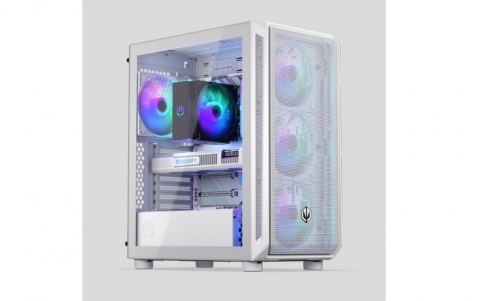
Intel Demos First 45nm Chips
Intel said it has produced what are believed to be the first fully functional SRAM (Static Random Access Memory) chips using 45nm process technology, its next generation semiconductor manufacturing process.
Today, Intel is using 65nm process technology for its semiconductors, with two manufacturing facilities making 65nm chips in Arizona and Oregon and two more coming online this year in Ireland and Oregon.
Intel is on track to manufacture chips with the 45nm technology in 2007 using 300mm wafers, continuing the company?s focus on pushing the limits of Moore's Law, by introducing a new process generation every two years. Moore's Law, coined by Intel co-founder Gordon Moore, states that the number of transistors on a chip will double every 18 months.
"Intel has a long history of translating technology leaps into tangible benefits that people appreciate. Our 45nm technology will provide the foundation for delivering PCs with improved performance-per- watt that will enhance the user experience," said said Bill Holt, vice president, general manger, Intel Technology and Manufacturing Group.
Intel's 45nm process technology will allow chips with more than five times less leakage power than those made today. This is expected to improve battery life for mobile devices and increase opportunities for building smaller, more powerful platforms.
The 45nm SRAM chip has more than 1 billion transistors. The prototype SRAM chip has a die sized at 119 square mm, offering a capacity of 153Mbit. The provided capacity is two times higher compared to previous SRAM prototypes manufactured with the 65nm process.
Though not intended as an Intel product, the SRAM demonstrates technology performance, process yield and chip reliability prior to ramping processors and other logic chips using the 45nm manufacturing process. It is a key first step in the march toward high-volume manufacturing of the world's most complex devices.
Intel also announced two high?volume fabs under construction to manufacture chips using the 45nm process technology: Fab 32 in Arizona and Fab 28 in Israel.
Intel is on track to manufacture chips with the 45nm technology in 2007 using 300mm wafers, continuing the company?s focus on pushing the limits of Moore's Law, by introducing a new process generation every two years. Moore's Law, coined by Intel co-founder Gordon Moore, states that the number of transistors on a chip will double every 18 months.
"Intel has a long history of translating technology leaps into tangible benefits that people appreciate. Our 45nm technology will provide the foundation for delivering PCs with improved performance-per- watt that will enhance the user experience," said said Bill Holt, vice president, general manger, Intel Technology and Manufacturing Group.
Intel's 45nm process technology will allow chips with more than five times less leakage power than those made today. This is expected to improve battery life for mobile devices and increase opportunities for building smaller, more powerful platforms.
The 45nm SRAM chip has more than 1 billion transistors. The prototype SRAM chip has a die sized at 119 square mm, offering a capacity of 153Mbit. The provided capacity is two times higher compared to previous SRAM prototypes manufactured with the 65nm process.
Though not intended as an Intel product, the SRAM demonstrates technology performance, process yield and chip reliability prior to ramping processors and other logic chips using the 45nm manufacturing process. It is a key first step in the march toward high-volume manufacturing of the world's most complex devices.
Intel also announced two high?volume fabs under construction to manufacture chips using the 45nm process technology: Fab 32 in Arizona and Fab 28 in Israel.





















